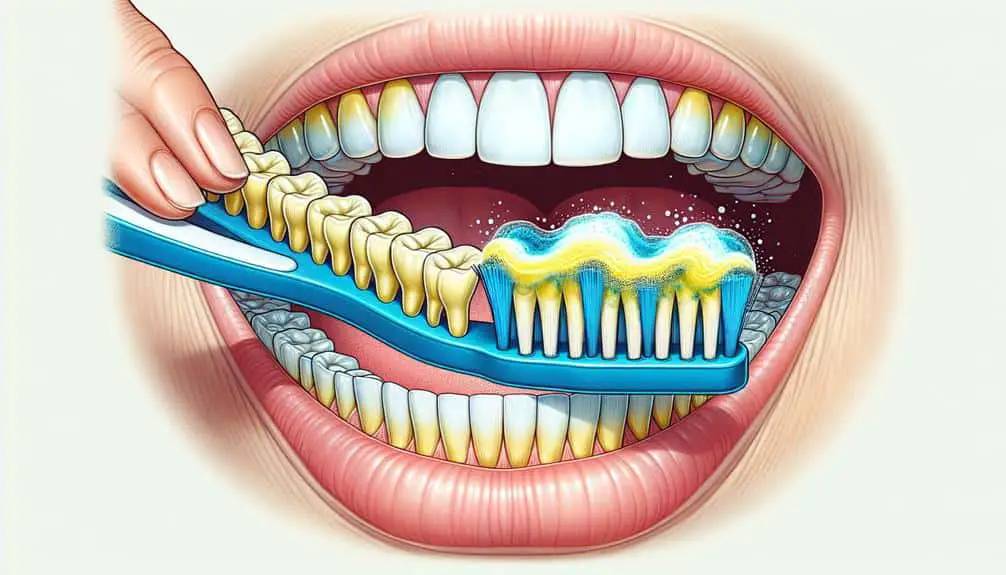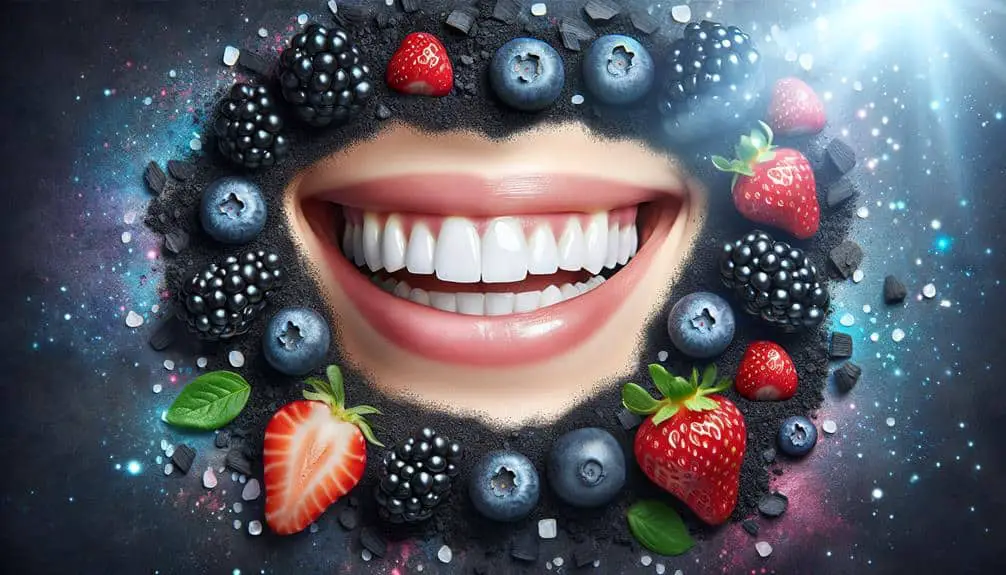Achieve a brighter smile by using fluoride stain removal tips. Brush with fluoride toothpaste regularly. Floss daily to prevent stains. Consider a DIY baking soda scrub. Make a paste with water for easy application. Lemon juice and salt paste can also help. Rinse thoroughly after using. Try activated charcoal solution to bind to stains. Consider professional whitening for quick results. Guarantee enamel protection during treatments. These tips can help you combat fluoride stains effectively and enhance your smile effortlessly.
Key Points
- Use baking soda scrub for gentle stain removal.
- Lemon juice and salt paste combat stubborn stains.
- Activated charcoal binds to and removes stains effectively.
- Consider professional whitening options for quick results.
- Maintain good oral hygiene to prevent future stains.
Understanding Fluoride Stains
When dealing with fluoride stains on your teeth, understanding the root cause is essential for effective removal. Fluoride stains occur when there's an excessive intake of fluoride during the tooth development stage, leading to discoloration. Preventing discoloration starts with maintaining good dental hygiene practices. Proper brushing with fluoride toothpaste, flossing daily, and regular dental check-ups are vital in preventing and managing fluoride stains.
Dental hygiene plays a significant role in the prevention of discoloration caused by fluoride. Brushing your teeth at least twice a day for two minutes each time helps remove plaque and prevent staining. Using a soft-bristled toothbrush and paying attention to all tooth surfaces ensures thorough cleaning. Additionally, incorporating mouthwash into your oral care routine can help remove any remaining food particles and bacteria that may contribute to staining.
Understanding the impact of fluoride on your teeth and practicing good dental hygiene habits are key steps in preventing and managing fluoride stains effectively. Regular visits to the dentist for professional cleanings and guidance on proper oral care further support your efforts in maintaining a healthy, stain-free smile.
DIY Baking Soda Scrub
For effective removal of fluoride stains on your teeth, consider trying a DIY Baking Soda Scrub. Baking soda is known for its gentle abrasive properties, making it a popular natural remedy in dental care.
To create a baking soda scrub, mix a small amount of baking soda with water to form a paste. Gently apply the paste to your teeth using a soft toothbrush or your fingertip, focusing on the areas with fluoride stains.
The mild abrasive action of baking soda helps to scrub away surface stains without being too harsh on your enamel. Additionally, baking soda has natural whitening properties that can help brighten your smile while removing fluoride stains.
After gently scrubbing your teeth with the baking soda paste, rinse your mouth thoroughly with water.
Incorporating this DIY baking soda scrub into your regular dental care routine can be an effective way to combat fluoride stains and maintain a healthy, bright smile using natural remedies.
Lemon Juice and Salt Paste
To further remove fluoride stains from your teeth, an alternative method worth considering is creating a paste using lemon juice and salt. This natural remedy harnesses the power of citrus cleaning properties found in lemon juice, combined with the abrasive texture of salt, to help eliminate stubborn stains on your teeth.
To make this paste, start by mixing a small amount of salt with a few drops of fresh lemon juice until a paste-like consistency forms. Gently apply this paste to your teeth using a soft-bristled toothbrush or your finger, ensuring to cover the stained areas thoroughly. Allow the mixture to sit on your teeth for a couple of minutes to allow the citric acid in the lemon juice and the abrasive nature of the salt to work their magic.
After a few minutes, thoroughly rinse your mouth and brush your teeth with regular toothpaste to remove any residue. Remember to use this method sparingly, as the acidic nature of lemon juice can potentially erode tooth enamel if used excessively.
Activated Charcoal Solution
Consider utilizing an activated charcoal solution as a potential method for removing fluoride stains from your teeth. Activated charcoal is known for its absorbent properties, making it effective in binding to toxins and stains on the teeth's surface. You can find activated charcoal in various forms, including charcoal toothpaste, which may offer convenience in application as a targeted fluoride stain removal option.
Home remedies incorporating activated charcoal often involve creating a paste by mixing activated charcoal powder with a small amount of water to form a thick consistency. Gently brush this paste onto your teeth, focusing on areas with fluoride stains. Allow the charcoal solution to sit on the teeth for a few minutes before rinsing thoroughly with water. Regular use of activated charcoal solutions as part of your oral hygiene routine may help diminish fluoride stains over time.
Incorporating activated charcoal into your teeth cleaning regimen can be a natural and cost-effective way to address fluoride stains, offering you a potential solution to enhance the appearance of your smile.
Professional Whitening Options
Explore professional whitening options offered by dental professionals to effectively brighten and enhance the appearance of your smile, complementing your efforts in addressing fluoride stains on your teeth. One popular method is laser treatment, where a dental professional uses a specialized laser to remove stains and brighten the enamel of your teeth. This treatment is quick, efficient, and can provide noticeable results in just one session.
When considering professional whitening options, it's important to look for treatments that also prioritize enamel protection. Enamel is essential for maintaining the strength and health of your teeth. Some professional whitening treatments include enamel protection measures to guarantee that your teeth aren't only whitened but also safeguarded against damage.
Consulting with a dental professional can help you determine the best whitening option for your specific needs. They can assess the extent of your fluoride stains and recommend a personalized treatment plan that will effectively remove stains while keeping your enamel protected. Prioritizing professional whitening options can lead to a brighter, healthier smile that you can confidently show off.
Frequently Asked Questions
Can Fluoride Stains Be Prevented in the First Place?
To prevent fluoride stains, focus on dental hygiene and dietary habits. Regular professional treatments and home remedies can aid in stain prevention. By being proactive, you can maintain a healthy smile and minimize the risk of developing stains.
Are There Any Long-Term Effects of Having Fluoride Stains on Your Teeth?
Having fluoride stains on your teeth can pose risks such as discoloration, weakened enamel, and increased susceptibility to tooth decay. Long-term effects may include compromised oral health and the need for professional interventions.
Can Children Also Benefit From These Fluoride Stain Removal Tips?
Children can benefit greatly from child-friendly techniques in preventing stains caused by fluoride discoloration. Pediatric dental care emphasizes early intervention to address fluoride stains effectively, ensuring long-term oral health for kids.
Are There Any Specific Toothpaste or Mouthwash Recommendations to Help Prevent Fluoride Stains?
For the best toothpaste and mouthwash to prevent fluoride stains, look for those with whitening properties and fluoride protection. These can act as shields against discoloration, keeping your smile bright and free from unwanted marks.
Is It Possible to Remove Fluoride Stains Naturally Without Using Any Abrasive Substances?
You can remove fluoride stains naturally without abrasives. Try using natural alternatives like baking soda or hydrogen peroxide. Whitening techniques such as oil pulling or activated charcoal can also help. Home remedies and professional treatments are available.



